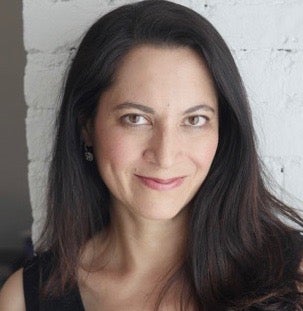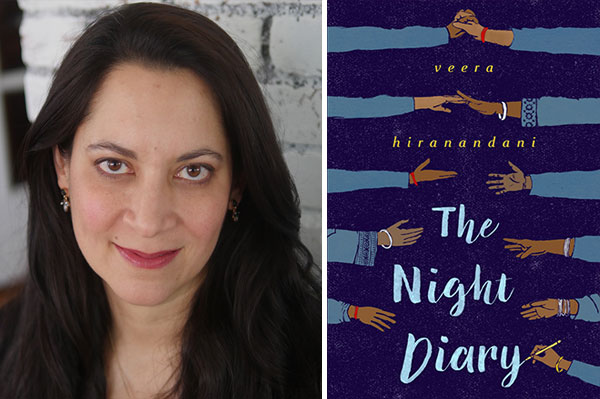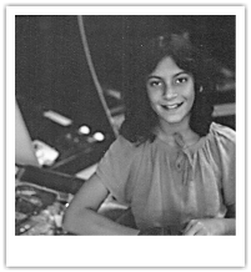
Veera’s grandfather was doctor in Mirpur Khas Sindh. Her father was nine when they had to leave their home several weeks after the partition in 1947.
Veera Hiranandani, the American author, who has earned fame for having penned several novels, including two novels on partition of subcontinent, is the blend of Sindhi and Jewish cultures, as she was born to Sindhi father and Jewish mother. She was raised in Connecticut.
Her father was nine when he had to leave his home in Sindh several weeks after partition in 1947. Until that time her father lived in Mirpur Khas, Sindh.
“My father’s family, at first, like many other families, just hoped they could stay. They heard about unrest and violence, but they weren’t quite in the center of things. Then the stories were getting closer and closer to them. There were several Hindu families that did stay in that area, but, ultimately, my father’s family felt it was too dangerous. They packed a few bags, got on a train, and left,” Veera shared her family background in an interview.
“They left a community they were connected to. My grandfather was a doctor at the Mirpur Khas City Hospital. They had beautiful compound and a really nice life. But they had to leave it all behind and start over in a very small apartment in Jodhpur, India,” she said.
Later, her father had moved to America where he married to an American-Jewish girl.
According to Veera, her growing up wasn’t always easy. “My mother was Jewish-American, my father from a Hindu family of India, and I didn’t know any kids like me where I lived. But coming from two cultures and not always fitting in has probably made me a stronger person. I was also pretty shy, so I spent a lot of time quietly watching other people,” she said.
“I liked video games a lot and since I grew up in the ’80s before the internet, going to the arcade and playing Pacman was just about the most exciting thing in the world. When I wasn’t begging my parents to take me to an arcade, I was reading, making up stories, doing gymnastics, baking cookies, drawing, and making my little sister play the games I wanted to play,” she told.
Veera’s first novel ‘The Whole Story of Half a Girl’ published in 2012 was based on her own life story – the story of a girl coming from two cultures. The novel was named a Sydney Taylor Notable Book and a South Asia Book Award Finalist.
About her education and career as writer, Veera told an interviewer, “When I graduated from George Washington University, I worked in the marketing department for a big, corporate law firm for a year and quickly headed back to graduate school.”
 “I studied fiction writing at Sarah Lawrence College which was wonderful because I got to spend all my time doing what I loved to do. Eventually, I became a children’s book editor at Simon and Schuster. I’ve also worked as a college admissions counselor and a Montessori teacher. Now, I spend much of my time writing and teaching writing. I live in a great little town on the Hudson River with my husband, daughter, son, and a very moody cat who we love anyway,” she said.
“I studied fiction writing at Sarah Lawrence College which was wonderful because I got to spend all my time doing what I loved to do. Eventually, I became a children’s book editor at Simon and Schuster. I’ve also worked as a college admissions counselor and a Montessori teacher. Now, I spend much of my time writing and teaching writing. I live in a great little town on the Hudson River with my husband, daughter, son, and a very moody cat who we love anyway,” she said.
“Maybe I wouldn’t have become a writer if I wasn’t forced to look at the world a little differently. Food was another thing that helped me connect with both sides of my family. I consider Jewish matzo ball soup and Indian samosas my favorite comfort foods. I love eating, cooking, and reading books about food. Nothing helps bring people together better than sharing a good meal. When I was younger, sometimes I wished I was different, but now I wouldn’t change my experiences for the world,” Veera says.
Her most recent middle-grade novel is ‘How to Find What You’re Not Looking For’.
Veera has earned several honors. Her Newbery Honor winning book ‘The Night Diary’ also received the 2019 Walter Dean Myers Honor Award, the 2018 Malka Penn Award for Human Rights in Children’s Literature, and several other honors and state reading list awards.
The Night Diary was chosen as a 2018 Best Children’s Book of the Year by The New York Times, The Washington Post, NPR, Amazon, School Library Journal, and Kirkus Reviews.
The Night Diary too has been written with background of 1947 Partition of India and a Hindu family violently uprooted from its home in Pakistan. The story is inspired by her father’s journey from Pakistan to India.
On a question ‘When did she first become aware of the history of the Partition and its impact on her family?’ Veera said, “I think it was a bit by bit progression. I got a little kernel when I was really young and a little more when I was older. That was partly because of my sensitivity or my sense of my father not wanting to share something that was difficult about the world and about his world. As I got older, I heard more family talk at gatherings and I’d ask more questions. My father minimized it at first, possibly out of a protective reaction, but later he started to feel more comfortable talking about it. I remember seeing the movie Gandhi when I was 11. It was the first time I’d heard about it outside my family—I realized what a large global event it was. Then I started to look into it on my own.”
“As a writer, I’m always looking back at my own history and my family’s history. I was circling around this for a long time, but wasn’t sure how to approach it.”
“I had wanted to tell the story for a while, and was finally feeling brave enough to attempt to do it justice. As I was writing and revising, I started to realize that there were themes that were resonating with the present day—certainly the refugee crisis and the experience of being a refugee – Also, the politically divisive feelings in our country and in the world. I was thinking about how quickly things can become so angry and divided, and how useful it can be to look at mistakes made in the past, in different parts of the world—how it can be a cautionary tale. It’s sad, but it also felt really useful to explore that history and put it on top of what was happening right now. I think we forget history so quickly, especially if it happens in another part of the world.”
“He read many drafts. That was exciting. He has an engineering background, and worked in business for a long time. He usually reads more nonfiction and history. This was probably his first experience talking about a work of fiction in progress. It was really interesting for both of us. And it was nice to be able to invite him into that space. He was great as far as pointing out when things didn’t feel authentic, in terms of place or history.”

She wasn’t able to do the exact journey like Nisha (a character of her novel), starting in Pakistan to Jodhpur and eventually Bombay. But she once visited Bombay with her father. She also navigated through internet looking at the political entities and how the transition happened. She read many nonfiction books, outlining different views as far as who was responsible [for Partition] in the larger political realm—the leaders, including the British, and Jinnah, Nehru, Gandhi, and the last Viceroy.
“I was also very interested in what was a regular person’s experience. And there’s an enormous amount of personal testimonies. I read hundreds describing what it was like to leave India and travel to Pakistan, and to go from Pakistan to India. I was always struck by how similar the accounts were, and how quickly things changed in communities—certainly in my father’s community—that had lived together for so long, and had respected each other’s differences in religion. It really did change overnight: a spreading distrust and fear that everybody experienced. A lot of it still sort of lingers today, which makes me sad. And that’s part of why I wanted to write this book—seeing the wound that is left in my family and in so many other families,” Veera says.
Throughout her novel ‘The Night Diary’, Nisha (main character) questions which side of the new border, if any, will welcome her as the child of a Muslim mother and a Hindu father. In her previous book ‘The Whole Story of Half a Girl’, Sonia navigates middle school life and both her Indian and Jewish-American heritage.
Speaking about these characters, Veera says, “Sonia is much closer to my direct experience growing up. My mom is Jewish-American, and my dad, of course, is Sindhi Hindu from India. I grew up feeling not quite enough of one or the other. I would spend time with the Jewish side of my family, with cousins who had two Jewish parents, who went to Hebrew school, and had a Bar or Bat Mitzvah. And I spent time with the Indian side, who knew Hindi (Sindhi) and went to India more often.”
“My parents, in their getting together, let go of some of the religious and cultural traditions. I think they felt it would be less confusing. But I did feel a constant search for where I belonged and who would consider me authentic, in a sense. I was always looking for that clear identity, and I never really found it. I’m still looking, but I’m enjoying the search.”
Veera further stated, “I’m fascinated by how people identify themselves and why. It will probably always be a theme that I’ll be working with. So it was natural in a sense for Nisha to also be trying to understand her identity. And, of course, the stakes are really high for her. It gave me a window to explore the landscape of Partition in a way that I personally would want to look at it. How would you feel if you had this identity? What if you had both? Where would you belong? Because I would hear stories from my Hindu side of the family, and that was one perspective. But I’m always interested in the other side, too.”
Veera enjoys cooking. “That was one way for me to connect to both sides of my family, both by cooking and eating. I felt that on the Indian side of my family I could speak the language of food, of Indian food. That’s where I felt really comfortable expressing myself. And also on the Jewish side of my family, taking part in the Passover meal or making latkes—those are the places I strongly connect to my background.”
Veera says she read that it is estimated that 14 million people migrated during the partition in 1947 and it was the largest migration in history. “Yet this is a story that is often left out of or glossed over in at least American history books.”
“I remember when I saw the movie Gandhi with my family when I was 11 and that was the first time I had seen partition and India’s independence depicted anywhere else other than hearing about it from my family. So I didn’t really understand the magnitude of what happened until I saw that movie. Then I realized, no this happened to millions of people. It was really eye opening. I wrote this book certainly for young people who have this connection and want to see themselves and their family in a story. And then certainly for all those that don’t know about it.”
________________
Source: Kid Curated Books, Publishers Weekly, Veera Hiranandani